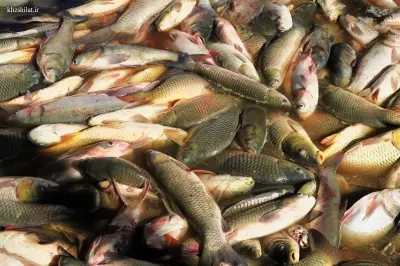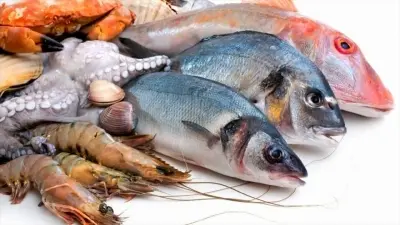Seafood consumption market in the Middle East

The seafood consumption market in the Middle East, including fish, shrimp and crab, has differences compared to other parts of the world. Cold water fish such as salmon, tuna and other cold water fish are more popular. On the other hand, in the coastal areas of the Persian Gulf, tropical fish such as Middle Eastern fish (Bahramula), caviar and small catfish are more popular. Middle Eastern people prefer the taste of fresh seafood. Therefore, the consumption market of fish and other fresh marine products is very prosperous in this area. Also, the use of local spices and various flavorings in these dishes also makes a difference.
Several West Asian countries have been investing in aquaculture to enhance local seafood production. Aquaculture helps reduce dependency on imports and supports the domestic seafood industry. Countries like Saudi Arabia, UAE, and Iran have established aquaculture farms for shrimp, fish, and other seafood products. These farms utilize advanced technologies and sustainable practices to improve productivity. Limited fishery resources and overfishing in the region pose challenges to meeting the growing seafood demand. Environmental factors like increasing water temperatures, pollution, and habitat degradation can impact the availability and quality of seafood. However, these challenges also present opportunities for sustainable fisheries management, conservation efforts, and the adoption of innovative aquaculture practices.
Seafood consumption market in the Middle East, Read More ...
The most popular edible aquatics in the West Asia region

People of West Asian countries use different aquatics as food . In this area, due to the presence of sea coasts and rich aquatic resources, consumption of fish and other marine creatures is very common. For example, in the Persian Gulf countries such as Saudi Arabia, Qatar, Oman and the United Arab Emirates , fish consumption is very popular. Fish such as salmon, tuna, grouper, white fish and fish caught from the Persian Gulf are consumed as popular food in these areas.
Sultan Ibrahim is a local fish found in the Arabian Gulf. It is often served grilled or fried. Pomfret is a popular fish known for its delicate flavor and white flesh. It is commonly used in fish curries, fried preparations, and fish soups. Lobster is considered a luxury seafood item in West Asia. It is highly valued for its tender meat and is often served grilled, steamed, or in seafood platters. Crabs, both blue crabs and mud crabs, are popular in the region. They are used in various dishes, including crab curry, crab masala, and crab cakes. Mussels are consumed in West Asia, particularly in coastal regions. They are used in soups, stews, and pasta dishes.
The most popular edible aquatics in the West Asia region, Read More ...
Fisheries industry and aquaculture in Arab countries

In Arab countries, the modernization of the fishing industry has been considered as a strategic goal in the field of sustainable development and economic diversification. The fisheries and aquaculture industry in the Middle East and West Asia is developing and growing significantly. In this region, due to the presence of rich water resources, sea coasts and skilled labor, fishing activities and aquaculture are known as an important strategic and economic industry. Fish production is very important in this region, and all kinds of cold and warm water fish are grown along the sea coast and inland lakes. Some of the famous fish in this area include salmon, carp, tilapia and hormoz fish.
Optimum and sustainable management of water resources in the fisheries industry is also one of the goals of modernization. Due to the limitation of water resources in the Arab region, the optimal use of water and water management techniques such as the use of continuous water systems, water recovery, and the use of salt water and water purification, in order to manage water resources and prevent water wastage, are considered. Takes. Determining the standards of quality and health in the breeding and production of aquatic animals, regular monitoring and control of the fisheries industry and the implementation of laws and regulations in order to preserve the health of the products and protect the environment are also part of the modernization of the fisheries industry in Arab countries.
Fisheries industry and aquaculture in Arab countries, Read More ...
State of investment and trade in the Middle East fisheries industry

Arab countries are trying to attract foreign investment in the fishing industry. These countries are looking for the development and modernization of their fisheries industry and in this regard, they are trying to attract foreign investment. By attracting foreign investment, Arab countries can increase their production capacity. Foreign investment can directly access financial resources, advanced technology and equipment, technical and managerial skills, and new markets that improve performance and productivity in the fisheries industry.
Collaborative initiatives such as joint ventures, technology sharing, and knowledge exchange contribute to the growth and sustainability of the sector. Regional organizations like the Gulf Cooperation Council (GCC) and the Arab League play a vital role in facilitating cooperation and coordination among member countries. Investments in sustainable fisheries practices, research and development, and conservation initiatives are gaining importance in the West Asia region. Governments and stakeholders are focusing on measures to prevent overfishing, protect marine ecosystems, and promote responsible fishing practices. Investments are made in scientific research, marine protected areas, and initiatives to reduce bycatch and mitigate the environmental impact of the fisheries industry.
State of investment and trade in the Middle East fisheries industry, Read More ...






